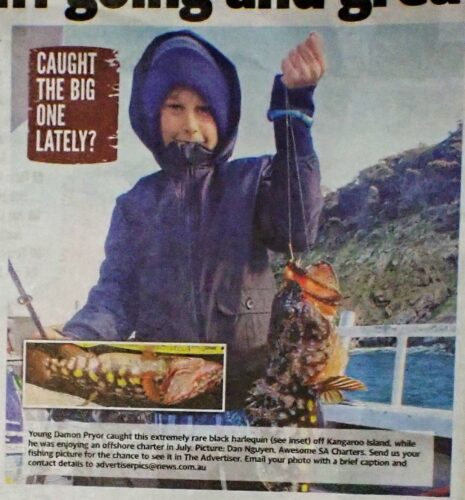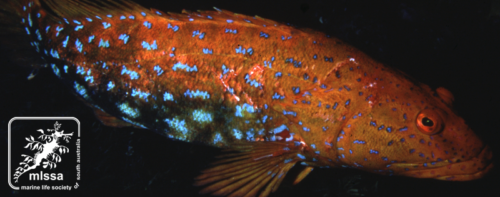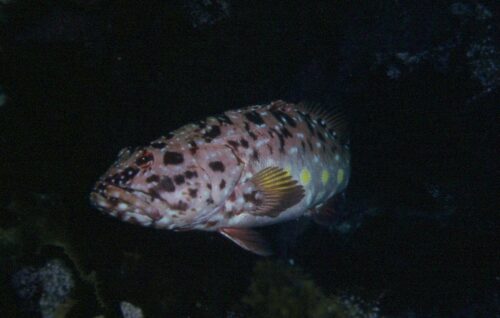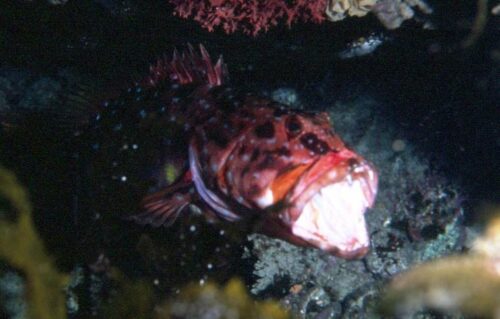Society member Chris Iwanicki found this ‘fishing photo’ of a Harlequin Fish recently: –

He brought it to our attention, saying “This picture reminded me again of the fact that most of the marine life has not any sort of protections in place and this needs to change to preserve multiple species. This “extremely rare black* harlequin” has no such protections either. It is overdue that protections are extended to address the spearfishing catch as well as total protections for a large number of species. It is a growing irony with me that the mainland has been exploited over some years to the point of multiple extinctions with a majority of habitats destroyed with typically resulting protections for almost every animal on the mainland (too little too late with many), yet oblivious to most people, perhaps because out of view under the waves rare and endangered marine fish get no such protections from over exploitation.”

We were able, for starters, to point out our “issues” page at https://mlssa.org.au/current-issues/harlequin-fish/ to Chris: –
“The Harlequin Fish (Othos dentex) is a southern Australian endemic with a limited geographic distribution (S.A. and W.A.), and a limited known depth range.
It is a site-associated on coastal reefs, over a narrow depth range, and has vulnerable population characteristics, similar to other species in the Serranidae family. Although there is a paucity of quantitative information about population sizes, it is likely that the relative abundance of this species in South Australia is much lower than in Western Australia.
There is concern that abundance may have declined over time in areas where water quality is reduced, and reefs are degraded. Harlequin Fish are caught by recreational fishermen, guests of charter fishing trips and (to a lesser extent) by commercial operators across its range by a number of methods.
Few controls are placed on its capture, particularly in South Australia, and no investigation of the potential impacts of fishing has been undertaken.”
(There are many comments attached to the above article.)
Chris did think that it was “such a shame something hasn’t happened already towards issues”. We told him that we can only keep pushing for change.
David Muirhead told us that he is “totally for full protection of the species”. He sent in this “Old, low res slide scan of a harlequin fish, taken along (the) NW KI coast via (a) small boat dive”: –

The slide came with the comments, “Of interest are the many (presumed) parasites on (the) head and anterior body …. (which I once imagined were juvenile Western Cleaner Clingfish but no longer feel able to say that with any conviction).”
David also sent in a second slide scan, saying “I am fairly sure (that it) is indeed another view of (the) same fish (on the) same dive:-

“(It) shows the classic client posture of a harlequin fish desperate for a clean. It probably had a heavy parasite load in its gills, and I’m willing to bet the hosts were Western Cleaner Clingfish, despite none being easily visible.”
* “However, I am not convinced that there is a (Harlequin Fish) morph that is black,” he said. “I think it simply depends on what the habitat’s main colour is, e.g. igneous vs limestone reef, and possibly also the individual fish’s distress reaction to being caught. Mainly the former though.”
Meanwhile, there is a link to some video footage of a Harlequin Fish at Port Noarlunga reef on our Issues page. The link to the YouTube video is https://youtu.be/coR0PIFF7C0 .
The video footage was taken by Paul G. Day of DayDreamTV on 28th December 2017. It shows the Harlequin Fish being cleaned by at least one Western Cleaner Clingfish, as can be seen in these stills from the video: –





Stills taken from video footage taken by Paul G. Day of DayDreamTV
showing a Harlequin Fish being cleaned by at least one Western Cleaner Clingfish
(Click on each photo to see a larger image.)
One of the comments attached to the Issues page at https://mlssa.org.au/current-issues/harlequin-fish/ came from well-known abalone diver Greg Pickering who said, “I would think the Harlequin worthy of some form of protection. Current bag limit of 6 per boat is ill-considered. They are far rarer than the Blue Groper.”
There is currently a bag limit of two Harlequin Fish per person, and a boat limit of six (when 3 or more people are fishing on board).
One of David Muirhead’s comments were “Harlequin Fish should undoubtedly receive full protection in all SA waters, as an urgent, obvious agenda and full protection would or should be so simple to achieve in legislative terms, yet that inertia we so often observe among our ‘top order legislators’ seems as resistive today as it’s seemed for decades. Ditto for our iconic site-associated Western Blue Groper, which must by any scientific assessment or criteria stand out as a key candidate for blanket protection.
“Why are these two species not yet fully protected in SA? When I boil it down to the essence, I can think of only 2 realistic reasons: either there is vested interest by certain groups in our community against full protection, or there is insufficient public awareness of these fishes’ plight to spur our political representatives into action i.e. ‘not enough votes in it’.”
(See also Harlequin Fish in peril in SA, still targeted – Marine Life Society of South Australia Inc. (mlssa.org.au) )
(Header photo taken from video footage taken by Paul G. Day of DayDreamTV.)
